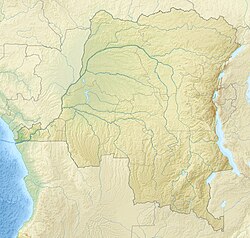Kinshasa is the capital and largest city of the Democratic Republic of the Congo. It is situated on the Congo River near Pool Malebo and forms a single urban area with Brazzaville which is the capital of the neighbouring Republic of the Congo. Considered a megacity, it is among the largest urban communities in Africa.
The origins of the modern-day city date to 1881 when a trading post was established on the site by Henry Morton Stanley on behalf of the International Association of the Congo. He named it Léopoldville (French) or Leopoldstad (Dutch) in honour of King Leopold II who was his patron and subsequently King-Sovereign of the Congo Free State established in 1885. It expanded rapidly and supplanted a number of nearby villages, including one a short distance to the east known as Kinshasa, and its importance as an administrative centre grew. Following the Free State's annexation, it superseded Boma as the capital of the Belgian Congo in 1926 and became the seat of the colonial administration and Governor-General. A residentially segregated city, the street-plan and general layout of the city centre dates to the Belgian colonial period. The population expanded rapidly as a result of rural migration from across the colony, particularly in the aftermath of World War II. By the late 1950s it became central to the spread of African nationalism in the Belgian Congo. The popular music genre of Congolese rumba first emerged in Léopoldville and Brazzaville in this period and Lingala spread as a lingua franca along populations around the Congo River. By 1959, Léopoldville had a population of more than 300,000 and was one of the biggest urban centres in Sub-Saharan Africa.
On independence in 1960, Léopoldville became the capital city of the newly formed Republic of the Congo and continued to expand rapidly during the Congo Crisis and under the regime of Joseph-Désiré Mobutu. As an early example of Mobutu's programme of retour à l'authenticité for the removal of foreign and colonial influences, the city was renamed Kinshasa in 1966 after a pre-existing African residential area. His regime constructed skyscrapers and other modern buildings in the city as a showpiece of his new Zairean regime. However, corruption and lack of investment led to rapid deterioration of the city's urban infrastructure after 1980 as it continued to expand rapidly in size. As of 2017, it had a population of almost 13 million and is the 21st largest city in the world.
